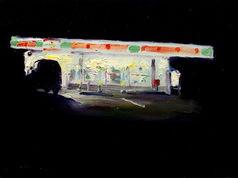
Click here for the Japanese version
"Fiftysix Convenience Stores" project
"Fiftysix Convenience Stores" is a landscape painting series by Masaya Yoshioka (1981–), portraying convenience stores in the style of Impressionism. The series was named "Fiftysix Views" because it initially comprised 56 works created between 2013 and 2024. (The collection continues to grow.)
The specific locations where each scene was painted are not disclosed, and each work is individually titled “Everyone’s Convenience Store.” This reflects the idea of featuring an ordinary convenience store within an ordinary landscape—something that could be found anywhere. While the subject matter is different, the approach is similar to that of The Great Wave off Kanagawa in Hokusai’s Thirty-Six Views of Mount Fuji.
While Mount Fuji has long been revered—so much so that places offering a view of it are called “Fuji-viewpoints”—convenience stores are so familiar that one might visit them in pajamas without a second thought. Yet, from an international perspective, convenience stores may be seen as iconic elements of the Japanese landscape, alongside Mount Fuji. Japan’s lack of awareness of this could be likened to the period before ukiyo-e gained recognition abroad.
The "Fiftysix Convenience Stores" project reintroduces a collection of works, created intermittently from the artist’s intuition that convenience stores make compelling subjects for painting, as a cohesive series. Its aim is to expand the reach of these convenience store paintings from within to the outside world, making them widely accessible.
About Fiftysix Convenience Stores
Text by Yoichi Tamori (Minnano Gallery)
Fiftysix Convenience Stores is an ongoing series of landscape paintings by Masaya Yoshioka, begun in 2013. Each painting quietly captures a rural convenience store in Japan—locations that feel at once familiar and indistinct—rendered in a painterly style reminiscent of Impressionism. Though the subject is thoroughly modern, the works are infused with light, atmosphere, and a sense of time, echoing the defining qualities of Impressionist painting. Most of the series was painted during the 2010s—a decade that, in retrospect, seems marked by a persistent sense of stagnation, during which Japan faced numerous social and structural shifts, both large and small. And yet, even in such times, convenience stores remained constant—ubiquitous symbols of daily life, spreading to every corner of the country and greeting us in the same familiar form wherever we went. In 2016, Sayaka Murata’s novel Convenience Store Woman was published, garnering widespread acclaim both in Japan and internationally. If that novel portrayed a person living within the system of the convenience store, then Fiftysix Convenience Stores gazes at it from outside, as landscape. Both works, in different media—literature and painting—attempt to capture the spirit of the same era from different angles. But the convenience store itself is not unchanging. Looking at nationwide statistics, the number of stores appears to have peaked in 2019, with the figures plateauing ever since. Demographic decline, rural depopulation, labor shortages, strained logistics, rising material costs, and inflation—these various forces are slowly but unmistakably reshaping what was once thought of as an unchanging part of everyday life. In fact, some works in the series depict brands that no longer exist—Circle K Sunkus, for instance. The once-ordinary scenes they portray now begin to carry the weight of time, taking on the character of historical records—landscapes of a particular era that has already begun to fade. The title Fiftysix Convenience Stores is a deliberate echo of Thirty-Six Views of Mount Fuji by Katsushika Hokusai. From within Japan, it may not be easy to see, but perhaps the convenience store has become a visual icon of contemporary Japan—one that rivals Mount Fuji in recognizability. Just as ukiyo-e once depicted the lives and spaces of ordinary people, Yoshioka’s work paints the contemporary, the familiar, the overlooked. Rendered in an Impressionist manner, the series suggests a lineage: from ukiyo-e, to Impressionism, to this quiet record of the present. Another artistic precedent that comes to mind is Ed Ruscha’s Twentysix Gasoline Stations, published in 1963. That series, documenting roadside gas stations in the American West with cool detachment, shares a similar focus on ordinary, mass-cultural landscapes. Looking at Ruscha’s nighttime photos of gas stations, one can’t help but be struck by how closely they resemble Yoshioka’s nighttime scenes of convenience stores. One is the American roadside; the other, the rural Japanese suburb—but both seem to reveal a universality hidden in the local. In a world that is constantly changing, Fiftysix Convenience Stores asks us to pause and look again at the everyday landscapes we’ve taken for granted. To see them. To preserve them. And, through quiet attention, to carry them forward.
● Events
Solo Exhibition
Masaya Yoshioka | Fiftysix Convenience Stores with the Mon℃ Collection
November 20 (Thu) – December 14 (Sun), 2025
12:00 PM – 7:00 PM (Closed on Mondays)
As the kickoff of the Fiftysix Convenience Stores project, the series will be exhibited from May 20th at "Minnano Gallery" in Ueno, Tokyo. Please take this opportunity to enjoy the charm of these convenience store paintings.
May 20 (Tue) – June 1 (Sun), 2025
12:00 PM – 8:00 PM (Closed on Mondays)
Venue Access


● Works Year: 2013-2025 / Each size: 333 x 242 mm / Oil on canvas

© Minnano Gallery























